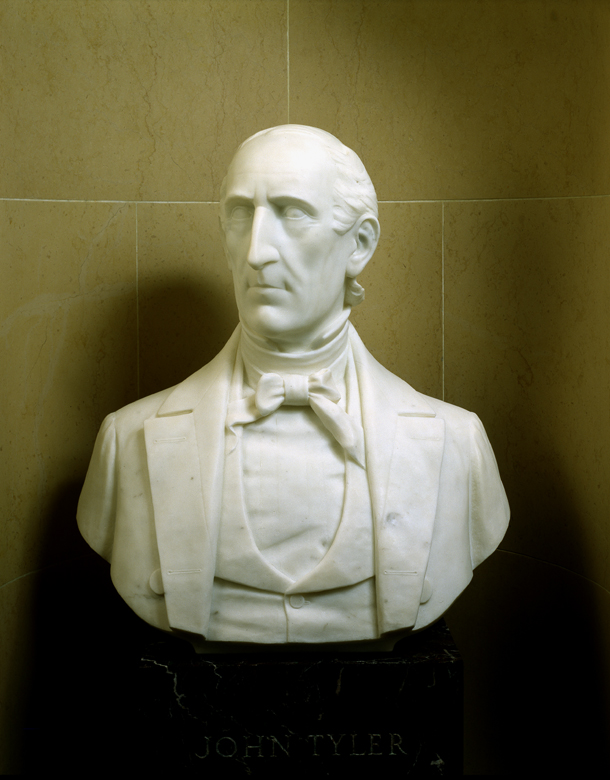
| Title | John Tyler |
| Artist/Maker | William C. McCauslen ( 1860 - 1929 ) |
| Date | 1898 (carved), 1896 (modeled) |
| Medium | Marble |
| Dimensions | h. 30 x w. 27 x d. 15 in. (h. 76.2 x w. 68.6 x d. 38.1 cm) |
| Credit Line | U.S. Senate Collection |
| Accession Number | 22.00010.000 |
In 1898 the Joint Committee on the Library chose sculptor William McCauslen to execute a likeness of John Tyler, following the recommendation of two of Tyler’s sons, Lyon Gardiner Tyler and Representative David Gardiner Tyler. In the spring of 1896, they had seen and admired a model for a bust of their father in McCauslen’s Washington, D.C., studio.
The original 1886 legislation establishing a Vice Presidential Bust Collection had called for busts to be installed in the gallery-level niches of the Senate Chamber, but by 1897 all of these spaces had been filled. On January 6, 1898, the Senate passed an amending resolution authorizing additional vice presidential busts for placement “in the Senate wing of the Capitol.” The Tyler bust was the first work commissioned and acquired under this new legislation.
Born and trained in Ohio, McCauslen was both a painter and a sculptor, though few of his works are known today. The only important examples of his public sculpture are the Tyler bust and those of Andrew Johnson and William R. King, also in the Senate’s Vice Presidential Bust Collection.
Because the subject was long deceased, the Tyler commission presented McCauslen with a distinct challenge. Several pictorial resources existed, the best known of which was probably George P.A. Healy’s oil on canvas portrait, painted from life in 1859 and now part of the White House collection. However, because McCauslen was charged with depicting Tyler as vice president, the artist apparently searched for an earlier life portrait. He found one in a lithograph drawn from life and published by Charles Fenderich in 1841, just after Tyler’s accession to the presidency. In pose, facial contour, and costume, McCauslen’s marble portrait of Tyler bears a strong resemblance to Fenderich’s lithograph. The completed bust was placed in the Capitol in 1898.
John Tyler was the first vice president of the United States to succeed to the presidency upon the death of his predecessor. Tyler also served as both U.S. representative and U.S. senator from Virginia. Born in Charles City County, he was voted into the state legislature in 1811, at the age of 20, and was elected to the U.S. House of Representatives in 1816. Tyler won the Virginia governorship in 1825 and then ran successfully for the U.S. Senate two years later. He opposed many of Andrew Jackson's policies and eventually aligned himself with the Southern states' rights wing of the new Whig Party. Tyler resigned from the Senate in 1836 in defiance of the Virginia legislature's instructions that he vote to expunge the Senate's 1834 censure of President Jackson. The censure, which Tyler had supported, rebuked the president for removing federal deposits from the Bank of the United States, which had been rechartered despite Jackson's opposition.
Tyler ran successfully for vice president in 1840 with William Henry Harrison in the famous "Tippecanoe and Tyler Too" campaign. President Harrison died only one month after his inauguration, and Tyler became the nation's 10th president. He alienated party leaders, however, by his stance against a national bank with branches in the states. Most of his cabinet subsequently resigned. Despite such political difficulties, Tyler initiated the annexation of Texas. Also during Tyler's administration, the Webster-Ashburton Treaty was negotiated with Great Britain, which redefined the boundaries between Maine and New Brunswick, Canada, and provided for mutual cooperation in the suppression of the slave trade.
Following his term in office, Tyler remained active in pre-Civil War compromise efforts from his Virginia home, Sherwood Forest. Eventually he declared for secession and served in the provisional Congress of the Confederacy. He won a seat in the Confederate house of representatives but died in Richmond in 1862 before beginning his term.